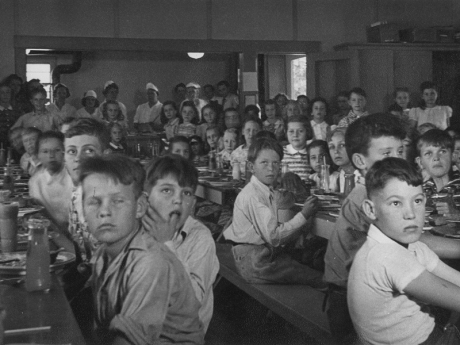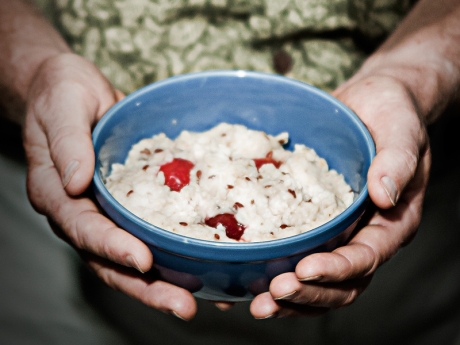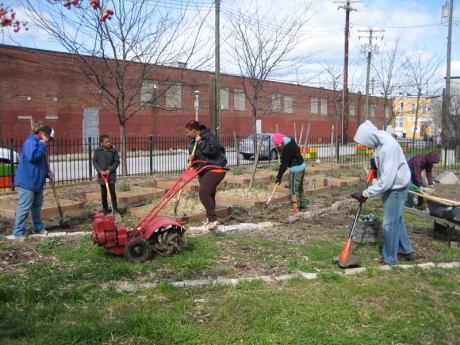Hunger and Food Insecurity
Background
To many people hunger means not just symptoms that can be diagnosed by a physician; it bespeaks the existence of a social, not a medical problem.1
– President's Task Force on Food Assistance, 1984

Although the United States has been called the “land of plenty,” more than 14 percent of U.S. households in 2013 experienced food insecurity at times during the year.3
Photo credit: Michael Milli, Johns Hopkins Center for a Livable Future.
Hunger can refer to the discomfort, weakness, illness, or pain caused by a long-term lack of food.2 Although the United States has been called the “land of plenty,” more than 14 percent of U.S. households in 2013 experienced food insecurity at times during the year—a condition that can include household members going hungry because they can’t afford enough food, as well as having to skip meals, compromise on nutrition, or rely on emergency food sources such as food banks, food pantries, or soup kitchens.3
Hunger and food insecurity are large and complex problems, in part because they are closely tied to poverty. The presence of hunger and food insecurity in the U.S. raises questions of why they prevail, how they should be addressed, and who should be responsible for addressing them.
Federal Food and Nutrition Assistance

“Food and nutrition would be at least as important as metals and munitions.” – President Franklin Roosevelt
In 1940, an estimated two out of five World War II draftees were deemed unfit for service, most often because of poor nutrition during childhood.9 The National School Lunch Program was established six years later in the hopes of fostering healthier citizens—and more able-bodied soldiers.
Photo public domain.
The first time hunger in the U.S. gained significant attention from policymakers was during the 1930s, when the Great Depression left a quarter of the American workforce unemployed.4 While U.S. farmers were producing more food than they could profitably sell, millions of Americans were hungry—a “paradox of want amid plenty.”5
Hoping to solve both problems, Congress authorized the government to purchase surplus wheat from farmers and donate it to hunger relief efforts.6–8 This represented a major shift in the role of the U.S. government, as hunger relief had traditionally been the role of private charities.7 Critics of the program argued that government “handouts” would undermine America’s work ethic and the dignity of citizens who received them.7
Despite objections against it, federal food and nutrition assistance would expand over the following years. A temporary food stamp program was established in 1939,6 followed by the National School Lunch Program in 1946.9
Such programs were not, however, sufficient to keep hunger at bay. A series of investigations in the 1960s reported evidence of widespread hunger in the rural South, followed by the award-winning CBS News documentary Hunger in America, which shed light on the issue. The public was shocked to learn of hunger in a country with such an abundant food supply, and reacted with outspoken criticism of federal programs, calling for greater assistance to the poor.7,9,10 The government responded by establishing the School Breakfast Program, free and reduced-price meals in schools, and the Special Supplemental Nutrition Program for Women, Infants and Children (WIC). It also expanded the Food Stamp Program, which is now called the Supplemental Nutrition Assistance Program, or SNAP.10
Today, about one in four Americans participates in at least one federal food and nutrition assistance program at some point during the year.11
Emergency Food Programs

Some have argued that the proliferation of emergency food programs, such as food banks and soup kitchens, indicates a failure on society’s part to address the root causes of poverty.12
Photo credit: Michael Milli, Johns Hopkins Center for a Livable Future.
During the early 1980s, the U.S. economy entered a severe recession that left many Americans unemployed. Federal budget cuts, meanwhile, weakened many social support programs.12 These events coincided with a dramatic rise in poverty,6 while hunger and homelessness became increasingly apparent.6,12
America’s poor turned to food banks, food pantries, soup kitchens, and other emergency food programs for help. To meet the urgent need, the size and number of emergency food programs multiplied over the course of just a few years; in New York City, 100 new emergency food programs opened in 1983 alone.12 Today, emergency food programs provide assistance, at least during parts of the year, to more than one in 20 Americans.13 Millions of Americans support these programs through donations of food, money, and volunteer labor.12
Some have argued that the proliferation of emergency food programs indicates a failure on society’s part to address the root causes of poverty. The argument goes on to suggest that by making charitable donations, Americans alleviate the discomfort evoked by seeing hunger and poverty, creating a “culture of charity” that allows the government to “dismiss its responsibility for the poor.” This arrangement has been described as “kinder, but less just,” referring to the role of charity in a society that lacks legal obligation to uphold its citizens’ right to food.12
Food Insecurity

Children may be particularly affected by food insecurity. Studies have found links between food insecurity and poorer academic performance, school absences, suspension from school, involvement in fights, headaches, depression, and other physical, emotional, and behavioral concerns.19,21–23
Photo credit: Richard Phillip Rücker, 2006. Wikimedia. Creative Commons CC BY 2.0.
By the time someone experiences hunger, they may already have suffered harm. For this reason, U.S. policymakers and public health advocates have expanded their attention from a narrow focus on hunger to the broader concept of food insecurity, which includes conditions that can lead to hunger.14
Food security means having consistent access to enough safe and nutritious food, and being able to get it without resorting to emergency food programs, scavenging, or stealing.15,16 In Latin, “secure” means “without worry.” A food secure family does not worry about whether they can eat well from day to day, whereas a food insecure family may be forced to skip meals, be unable to afford balanced meals, or be worried their food will run out before they can afford to buy more .17
Food security in a region depends on three factors: First, does the region produce enough food for its people? Second, is the food supply stable, e.g., robust enough to weather droughts? Third, do people have physical and economic access to food?18 In the U.S., where the food supply is abundant and stable, access to food is the primary concern.
Poverty is frequently cited as the root of food insecurity. In the U.S., low-income households are much more likely to be food insecure.17 Unemployment, low wages, physical and mental illness, and other burdens can make it difficult to obtain adequate, nutritious food—particularly when food budgets must compete with other priorities, such as housing, medical, and child-care costs.19
Food insecure households may face greater health risks. Food insecurity has been linked to obesity, diabetes, nutrient deficiencies, low fruit and vegetable intake, and other indicators of unhealthy diets.19 Families that live far from supermarkets and lack reliable access to transportation may be particularly affected.20
Community Food Security

Community garden in Baltimore.
The community food security movement strives to build self-reliance, empowering people to obtain food for themselves.
Photo credit: Brent Kim, Johns Hopkins Center for a Livable Future.
While federal food and nutrition assistance and emergency food programs provide much-needed nourishment in times of need, the community food security movement strives to empower people with the means to procure food for themselves.14 Community food security is “a condition in which all community residents obtain a safe, culturally acceptable, nutritionally adequate diet through a sustainable food system that maximizes community self-reliance, social justice, and democratic decision-making.”18
Educational programs, for example, can teach people how to grow, preserve, and prepare produce for themselves and their community. With small loans and entrepreneurial training, community members can start up small businesses that produce food for farmers’ markets, stores, and restaurants. The movement also works to improve access to healthy food by establishing community gardens, urban farms, and farmers’ markets.14
These examples demonstrate how the community food security movement strives to promote local decision making and grassroots citizen engagement, in contrast to “top-down” programs shaped by decisions made by the federal government.14,18
Unlike programs that focus only on eating, the community food security movement takes a “systems approach”—bringing together representatives from across the food system (e.g., farmers, chefs, community members, and policymakers), and accounting for how and where food is produced, processed, distributed, and sold.14,24
Resources
The following list of suggested resources is intended as a starting point for further exploration, and is not in any way comprehensive. Some materials may not reflect the views of the Johns Hopkins Center for a Livable Future.
For teachers
- The Hunger Gap (lesson plan). FoodSpan. Johns Hopkins Center for a Livable Future.
- Why We Eat What We Eat (lesson plan). FoodSpan. Johns Hopkins Center for a Livable Future.
- Introduction to the US Food System: Public Health, Environment, and Equity (textbook). Neff RN (editor). Johns Hopkins Center for a Livable Future. 2014.
Reports
- Vacant Lots to Vibrant Plots: A Review of the Benefits and Limitations of Urban Agriculture. Santo R, Palmer A, Kim B. Johns Hopkins Center for a Livable Future. 2016.
- Community Food Security in the United States: A Survey of the Scientific Literature. Chen W, Clayton ML, Palmer A. Johns Hopkins Center for a Livable Future. 2015.
- Current and Prospective Scope of Hunger and Food Security in America: A Review of Current Research. RTI International. 2014.
- Agroecology and the Right to Food: Report Submitted by the Special Rapporteur on the Right to Food. Olivier De Schutter. United Nations. 2010.
Websites
- Feeding America. Map the Meal Gap: Food Insecurity in the United States (interactive map).
- Food Research and Action Center.
- Healthy Food Access Portal. PolicyLink and The Food Trust.
- WhyHunger.
Academic journal articles
- Strengthening Vendor Standards in the Supplemental Nutrition Assistance Program: Are Healthier Foods Within Reach? (open access) Kennelly ME, Neff R, Rutkow L. Journal of Health Care Law & Policy. 2013.
- Community Food Security and Nutrition Educators (requires subscription). Hamm MW, Bellows AC. Journal of Nutrition Education and Behavior. 2013.
- Food Insufficiency and American School-Aged Children's Cognitive, Academic, and Psychosocial Development (requires subscription). Alaimo K, Olson CM, Frongillo, Jr EA. Pediatrics. 2001.
Film
- Food Frontiers. Johns Hopkins Center for a Livable Future. 2016.
References
- President’s Task Force on Food Assistance. Report of the President’s Task Force on Food Assistance. Washington, DC; 1984.
- USDA Economic Research Service. Food Security in the United States: Definitions of Hunger and Food Security. 2011.
- Coleman-Jensen A, Gregory C, Singh A. Household Food Security in the United States in 2013. USDA Economic Research Service; 2014.
- McElvaine RS. The Great Depression: America, 1929-1941. Random House Digital, Inc.; 1993.
- Poppendieck J. Breadlines Knee Deep in Wheat: Food Assistance in the Great Depression. Rutgers University Press; 1986.
- Andrews M, Clancy K. The Political Economy of the Food Stamp Program in the United States. In: Pinstrup-Anderson P, ed. Political Economy of Food and Nutrition Policies. Washington, DC: International Food Policy Research Institute; 1993.
- Roth D. FOOD STAMPS: 1932 –1977: From Provisional and Pilot Programs to Permanent Policy. USDA ERS.
- Lambert CR. Herbert Hoover and Federal Farm Board Wheat. Herit Gt Plains. 1977;10(1).
- Levine S. School Lunch Politics: The Surprising History of America’s Favorite Welfare Program. Princeton, NJ: Princeton University Press; 2008.
- Parker L. The role of clinicians in helping patients achieve food security. Nutr Clin Care. 2002;5(4):149-151.
- USDA. Food Assistance and Nutrition Programs. 2011.
- Poppendieck J. Sweet Charity?: Emergency Food and the End of Entitlement. New York, NY: Penguin Group; 1999.
- Coleman-jensen A, Nord M, Andrews M, Carlson S. Household Food Security in the United States in 2010: Statistical Supplement.; 2011.
- Allen P. Reweaving the food security safety net: Mediating entitlement and entrepreneurship. Agric Human Values. 1999:117-129.
- Life Sciences Research Office, Federation of American Societies for Experimental Biology. Core indicators of nutritional state for difficult-to-sample populations. J Nutr. 1990;120(Suppl 11):1559-1600.
- Andrews M, Nord M, Bickel G, Carlson S. Household food security in the United States, 1999. USDA ERS. 2000.
- Coleman-Jensen A, Nord M, Andrews M, Carlson S. Household Food Security in the United States in 2010. 2011.
- Hamm MW, Bellows AC. Community food security: background and future directions. J Nutr Educ Behav. 2003;35(1):37-43.
- Haering SA, Syed SB. Community Food Security in United States Cities. Baltimore, MD; 2009.
- Ver Ploeg M, Breneman V, Farrigan T, et al. Access to Affordable and Nutritious Food: Measuring and Understanding Food Deserts and Their Consequences: Report to Congress. USDA Economic Research Service; 2009.
- Murphy JM, Wehler CA, Pagano ME, Little M, Kleinman RE, Jellinek MS. Relationship between hunger and psychosocial functioning in low-income American children. J Am Acad Child Adolesc Psychiatry. 1998;37(2):163-170.
- Alaimo K, Olson CM, Frongillo Jr EA. Food insufficiency and American school-aged children’s cognitive, academic, and psychosocial development. Pediatrics. 2001;108(1):44-53.
- Alaimo K, Olson CM, Frongillo EA. Family food insufficiency, but not low family income, is positively associated with dysthymia and suicide symptoms in adolescents. J Nutr. 2002;132(4):719-725.
- Winne M, Joseph H, Fisher A. Community Food Security: A Guide to Concept, Design and Implementation. Venica, CA; 1997.
